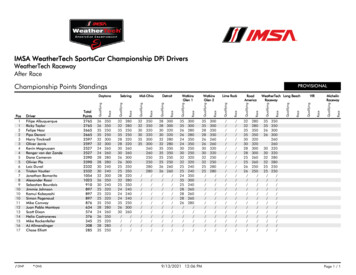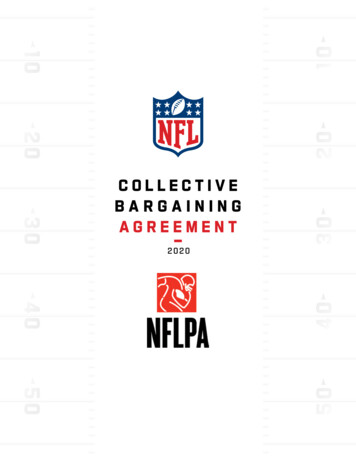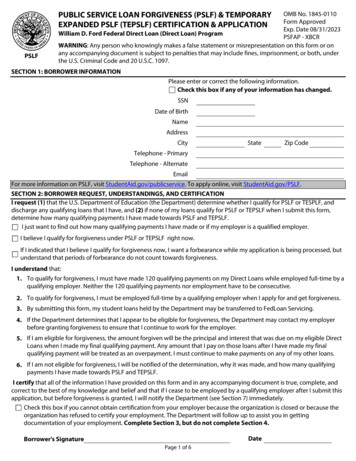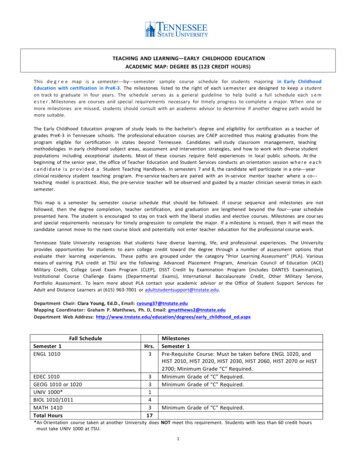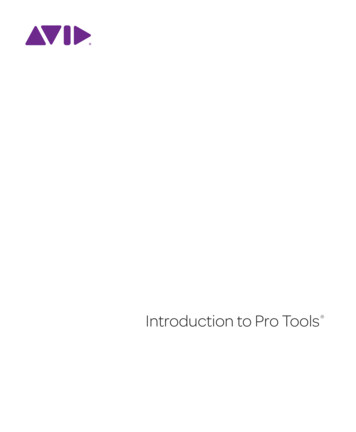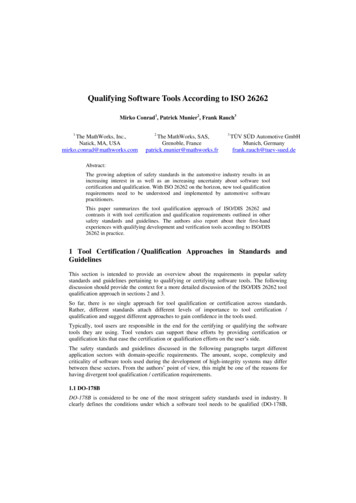
Transcription
Qualifying Software Tools According to ISO 26262Mirko Conrad1, Patrick Munier2, Frank Rauch31The MathWorks, Inc.,Natick, MA, USAmirko.conrad@mathworks.com2The MathWorks, SAS,Grenoble, Francepatrick.munier@mathworks.fr3TÜV SÜD Automotive GmbHMunich, Germanyfrank.rauch@tuev-sued.deAbstract:The growing adoption of safety standards in the automotive industry results in anincreasing interest in as well as an increasing uncertainty about software toolcertification and qualification. With ISO 26262 on the horizon, new tool qualificationrequirements need to be understood and implemented by automotive softwarepractitioners.This paper summarizes the tool qualification approach of ISO/DIS 26262 andcontrasts it with tool certification and qualification requirements outlined in othersafety standards and guidelines. The authors also report about their first-handexperiences with qualifying development and verification tools according to ISO/DIS26262 in practice.1 Tool Certification / Qualification Approaches in Standards andGuidelinesThis section is intended to provide an overview about the requirements in popular safetystandards and guidelines pertaining to qualifying or certifying software tools. The followingdiscussion should provide the context for a more detailed discussion of the ISO/DIS 26262 toolqualification approach in sections 2 and 3.So far, there is no single approach for tool qualification or certification across standards.Rather, different standards attach different levels of importance to tool certification /qualification and suggest different approaches to gain confidence in the tools used.Typically, tool users are responsible in the end for the certifying or qualifying the softwaretools they are using. Tool vendors can support these efforts by providing certification orqualification kits that ease the certification or qualification efforts on the user‘s side.The safety standards and guidelines discussed in the following paragraphs target differentapplication sectors with domain-specific requirements. The amount, scope, complexity andcriticality of software tools used during the development of high-integrity systems may differbetween these sectors. From the authors‘ point of view, this might be one of the reasons forhaving divergent tool qualification / certification requirements.1.1 DO-178BDO-178B is considered to be one of the most stringent safety standards used in industry. Itclearly defines the conditions under which a software tool needs to be qualified (DO-178B,
section 12.2), i.e. tool qualification is required if the answer to each of the following threequestions is ‗yes‘:(1) Can the tool insert an error into the airborne software or fail to detect an existing errorin the software within the scope of its intended usage?(2) Will the output of the tool not be verified as specified in Section 6 of DO-178B?(3) Will the output from the tool be used to meet or replace an objective of DO-178B,Annex A?Tool qualification is defined as the ―process necessary to obtain certification credit1 for asoftware tool within the context of a specific airborne system‖ (DO-178B, Glossary)There are two types of tools that may require qualification: development and verification tools.If the answer to the question:(4) Is the tool output part of the airborne software, such that the output can insert an errorinto the software?is ‗yes‘ the tool needs to be qualified as development tool, otherwise it needs to be qualified asverification tool. Verification tools are simpler to qualify, because they cannot, by definition,inject errors into the final product.Development tool qualification requires that the development process for the tool satisfies thesame objectives as the software development process of the airborne software. The softwarelevel assigned to the tool is the same as for the airborne software it produces unless theapplicant can justify a reduction of the tool‘s software level to the certification authorities.Verification tool qualification requires the user to demonstrate that the tool complies with itsoperational requirements under normal operation conditions. In practice this can be achievedwith documented tool operational requirements and a set of test cases that allow one to verify,that the tool correctly implements these requirements under normal operating conditions.Tools need to be qualified on a per project basis. Tool qualification activities are subject to aplanning phase that is documented in a tool qualification plan. Using qualified tools allows oneto achieve dedicated certification credits.DO-178B tool qualification is widely discussed e.g. in [HB07, KZ09].1.2 IEC 61508IEC 61508 (Ed. 1.0) includes the concept of tool certification. The standard recommends (forSIL 1) or highly recommends (for SIL 2-4) the use of certified tools and translators (IEC61508-3, table A.3). Wherever possible, tools should be certified so that some level ofconfidence can be assumed regarding the correctness of their outputs (IEC 61508-7, clauseC4.3.). As an alternative, tools with increased confidence from use are highly recommended forall SILs.The standard provides little guidance on how to certify a tool. As a result a variety of differenttool certification approaches has been used in practice [KM03, JG03, Glö08, TMW08,TMW09, SLM09, BB09]. Developing a software tool as per IEC 61508-3 is just one ofmultiple options here.Tool certification is viewed as a generic measure to increase the confidence in the tools used, ifincreased confidence from use cannot be claimed. No certification credits are offered in1Acceptance by the certification authority that using a tool satisfies a certification requirement
exchange for tool certification. This way there is little incentive for applicants to certify tools ifit can be avoided. Requirements for tool qualification are limited, because the IEC 61508software life cycle for embedded software is set-up to uncover potential tool errors.IEC 61508-3 also emphasizes the use of an integrated tool chain (IEC 61508-3, clause 7.4.4.2).The upcoming second edition IEC 61508 (Ed. 2.0) distinguishes between online2 and offline3tools. Software offline support tools are divided into the following categories (cf. IEC 61508-4Ed. 2.0, clause 3.2.11): T1: tools that cannot directly or indirectly contribute to the executable code of thesystemT2: tools supporting verification or test of the design or the executable code; errors inthese tools can fail to reveal defectsT3: tools generating outputs that can directly or indirectly contribute to the executablecode of the systemDepending on the tool‘s classification, the identification of use cases and related hazards isrequired. T3 offline tools require evidence that the tool conforms to its specification or manual.This evidence may be based on confidence from use or on application independent validation.If such evidence is not available, application-specific measures to uncover potential tool errors,such as back-to-back testing, could be implemented by the applicant.Each new version of an off-line support tool shall be qualified. This delta qualification may relyon evidence provided for an earlier version.Both editions of IEC 61508 very much value confidence from use as a measure to gainconfidence in the tools used.1.3 ISO/DIS 26262Although ISO/DIS 26262 is considered a derivative standard of IEC 61508, tool qualificationapproaches in these two standards differ significantly.ISO/DIS 26262 contains detailed guidance on software tool qualification (ISO/DIS 26262-8,11). The objective of tool qualification is to provide evidence that a software tool is suitable foruse in the development of safety-related software according to ISO/DIS 26262.The use cases for a tool need to be documented and analyzed. This analysis shall evaluate if themalfunctioning software tool or its erroneous output can lead to the violation of a safetyrequirement. In addition, the probability of preventing or detecting such errors in the output ofthe tool needs to be evaluated. Based on this analysis, a required tool confidence level (TCL) isdetermined.The required TCL, together with the Automotive Safety Integrity Level (ASIL) of the safetyrelated software developed using the software tool, guides the selection of the appropriate toolqualification methods. These tool qualification methods are listed in tables 2, 3, and 4 ofISO/DIS 26262-8.Increased confidence from use is one of the possible qualification methods, however the levelof recommendation in the above mentioned tables decreases for the higher TCLs and ASILs.2Software on-line support tool: software tool that can directly influence the safety-related embedded systemduring its run time3Software off-line support tool: software tool that supports a phase of the software development life cycle;cannot directly influence the safety-related embedded system during its run time
With this approach, ISO/DIS26262 provides very detailed guidance to classify the tools and toestimate the required level of tool qualification. However, unlike earlier draft versions,ISO/DIS 26262 does not distinguish between different tool categories.Details of the ISO/DIS 26262 tool qualification will be discussed in chapters 2 and 3. [Sau09]touches upon this topic as well.1.4 MISRA-CMISRA-C sees compilers and static checking tools as trusted processes. This means that there iscertain level of reliance on the output of the tools. It needs to be ensured that this trust is notmisplaced (MISRA-C:2004, section 4.2.3).MISRA-C:2004 suggests documented validation testing as the method of choice to gainconfidence in the tools used.Ideally, the tool supplier should carry out the validation tests. The tool vendor should be able toprovide records of the verification activities and change records to document a controlledsoftware tool development. The tool vendor should also have a bug reporting and trackingmechanism. The size of the user base together with an assessment of the bugs reported over thelast 6-12 months is seen as an indication of the stability of the tool.If tool validation information is not available from the tool vendor, confidence in the tool canbe gained by the tool user for example by adopting the following approaches: Documented validation testingAssessment of the development processes use by the tool supplierReview of the tool‘s performance2 The ISO/DIS 26262 Tool Qualification ApproachThis section provides a brief overview about the tool qualification approach as outlined in thedraft standard.2.1 ISO/DIS 26262ISO 26262 is an emerging international safety standard titled Road vehicles — Functionalsafety. This sector specific standard for the automotive industry is intended to be applied tosafety-related systems that include one or more E/E systems4, and are installed in seriesproduction passenger cars with a maximum gross weight of up to 3.5 tons.The draft international standard, ISO/DIS 26262 was published in summer 2009. Part 8 of thedraft international standard, ISO/DIS 26262-8 Supporting processes, addresses multiple crossfunctional topics, including the qualification of software tools.2.2 Tool Qualification OverviewThe use of software tools can simplify or automate activities and tasks required by ISO 26262for the development of safety-related software (ISO/DIS 26262-8, 11.2). The objective of ISO26262 software tool qualification is to provide evidence that a software tool is suitable for use4Systems that consists of electrical and electronic elements, including: programmable electronic elements, powersupplies, input devices, communication paths, and output devices.
in the development of safety-related software, such that confidence can be achieved in thecorrect execution of activities and tasks required by ISO 26262 (ISO/DIS 26262-8, 11.1).To determine the required tool confidence level (TCL), the use cases of the tool shall beanalyzed. This analysis shall evaluate: If a malfunctioning software tool and its erroneous output can lead to the violation ofany safety requirement allocated to the safety-related software to be developed.The probability of preventing or detecting such errors in the output of the tool.The evaluation considers measures internal to the software tool (for example, monitoring), aswell as measures external to the software tool (for example, guidelines, tests, and reviews) thatare implemented in the development process for the safety-related software.The required TCL, together with the Automotive Safety Integrity Level (ASIL) of the safetyrelated software developed using the software tool, allows the selection of the appropriate toolqualification methods. Tool qualification can be carried out for individual tools as well as fortool chains or sets of tools.The ISO/DIS 26262 tool qualification process requires the creation of the following toolqualification work products (ISO/DIS 26262-8, 11.5; see the appendix for a summary): Software Tool Qualification PlanSoftware Tool DocumentationSoftware Tool Classification AnalysisSoftware Tool Qualification Report2.3 Software Tool Qualification Plan (STQP)The software tool qualification plan is a planning document created in an early phase of thedevelopment of the safety-related system.Besides stating the applicant, and the application under consideration, it identifies the tool andtool version to be qualified, the intended configuration and operational environment. In thissense, the STQP shares conceptual similarities with tool qualification plans used in DO-178Bprojects.The tool qualification plan also lists the intended tool use cases. It is supposed to list the toolqualification methods and available means to detect malfunctions or erroneous output of thetool.2.4 Software Tool Documentation (STD)The software tool documentation comprises different information that the tool applicant mayneed when using the tool. It comprises information such as: tool overview, available tooldocumentation set, operational environment and constraints, installation instructions, knownissues.The STD also provides information necessary to check whether the use cases, configurationsand operational environment listed in the STQP are supported by the tool. It has similarities tothe description of tool operational requirements as per DO-178B.
2.5 Software Tool Classification Analysis (STCA)The tool classification is necessary to determine the required tool confidence level (TCL). Itdepends on the particular tool use cases used during the development of the application underconsideration. The tool confidence level can be derived using the schematics provided in Fig. 1.Fig.1: ISO/DIS 26262 Tool Classification SchemeTool Impact (TI)First, the intended use cases for the tool shall be analyzed to determine if a safety requirementcan be violated if the software tool is malfunctioning or producing erroneous output. If aviolation of a safety requirement is not possible, tool impact TI0 shall be chosen. Otherwise,the tool impact is TI1 (ISO/DIS 26262-8, 11.4.3.2.a).Tool Error Detection (TD)Second, the intended software tool use cases shall be analyzed to determine the probability ofpreventing or detecting that the software tool is malfunctioning or producing erroneous output.The degree of confidence, that a malfunction or an erroneous output from the tool can beprevented or detected, determines the tool error detection TD as outlined in Table 1 (ISO/DIS26262-8, 11.4.3.2.b).Tab.1: Tool Error Detection LevelsDegree of confidenceTool error detectionhighTD1mediumTD2lowTD3no systematic verification measures in subsequent development phasesmalfunctions or erroneous outputs can only be detected randomlyTD4Tool Confidence Level (TCL)If TI and TD have been chosen, the tool confidence level (TCL) can be determined followingthe schematics provided in Figure 1 (ISO 26262-8, 11.4.3.4).Having multiple use cases for a tool can potentially result in multiple TCLs. To determine therequired tool qualification measures, the maximum TCL required (TCLREQ) to support these usecases needs to be established. TCLREQ needs to be documented in the STQP.
Tool Qualification Methods (TCM)A tool classified at TCL1 does not require specific tool qualification methods to be carried out.For software tools classified at any of the other tool confidence levels, specific methods forsoftware tool qualification shall be applied. These specific methods are listed in ISO/DIS26262-8, tables 2, 3, and 4 and have ASIL specific recommendations. From the authors‘perspective, some of these methods seem to be feasible for commercial off the shelf tools only.As an example, permissible tool qualification methods for TCL2 are given in Table 2. Toqualify a tool classified at TCL2 up to ASIL D, methods 1b, 1c, 1d or a suitable combination ofthese could be used.Tab. 2: Tool Qualification Methods for TCL2MethodAASILBCD1a Increased confidence from use 1b Evaluation of the development process 1c Validation of the software tool 1d Development in compliance with a safety standard ( method recommended; method highly recommended)The selected tool qualification methods to be carried out need to be documented in the STQP.2.6 Software Tool Qualification Report (STQR)The software tool qualification reports documents the actual tool qualification, i.e. providesevidence that the tool qualification was carried out as planned. Usage constraints andmalfunctions identified during the qualification, if any, shall be documented here as well.3 Experiences with tool qualification according to ISO/DIS 26262 A practitioner’s perspectiveMathWorks automotive industry customers have expressed their need for compliance with theupcoming ISO 26262 standard [TMW09] and for tools qualified as per ISO 26262 in particular.In order to support this customer need, a practicable ISO 26262 tool qualification approach hadto be developed and implemented.In this section the authors discuss their first hand experiences with the ISO/DIS 26262 toolqualification approach gained during the qualification of the Real-Time Workshop EmbeddedCoder code generator and the PolySpace Client/Server for C/C code verifiers fromMathWorks. These qualification activities happened in 2009.3.1 Implementation of the ISO 26262 tool qualification approachISO 26262 allows different levels of qualification, including a self-qualification (1st partyqualification). To increase confidence into the proposed approach, MathWorks decided tosubmit the tool qualification approach to an accredited certification body for review andapproval. Due to their reputation for software tool certifications / qualifications according to
various standards, TÜV SÜD Automotive GmbH was chosen for the tool qualificationassessment.Due to their large customer base, MathWorks supports customers developing high-integritysystems according to different standards. Tool certification packages for IEC 61508 andqualification kits for DO-178B were already productized when the ISO 26262 qualificationactivities were launched. So it was desirable to re-use certification / qualification approachesand artifacts developed for these other standards wherever feasible.A suitable way to leverage existing certification approaches was to add the ISO 26262 toolqualification on top of the existing IEC 61508 in-context tool certifications. These existingcertifications are based on specific workflows (reference workflows) to be utilized by theapplicant when using the tool for developing or verifying software for IEC 61508 applications.In the context of ISO 26262 tool qualification, these workflows can be re-used to describe andlimit the intended tool use cases as well as to list available means to detect malfunctions orerroneous output of the tool.In the following, we will illustrate this approach using the Real-Time Workshop EmbeddedCoder code generator as an example:The reference workflow describes a workflow for application-specific verification andvalidation of models and generated code developed using the Simulink modelingenvironment and the Real-Time Workshop Embedded Coder C code generator. The mainconstructive development activities as well as the corresponding verification and validationactivities are summarized in Fig. 2. [Con09, CS09] provide more detailed discussions.Fig.2: Reference Workflow for Application Specific Verification and Validation of Models andGenerated CodeThe verification and validation measures described in this reference workflow form availablemeans to detect or prevent potential malfunctions or erroneous outputs of the code generator.This description was used to determine the tool error detection (TD) for the code generator.According to the certification report, applying the entire workflow for Application-SpecificVerification and Validation of Models and Generated Code provides a high degree ofconfidence that potential malfunctions or erroneous output of the code generator can bedetected or prevented, i.e. the tool error detection is TD1 resulting in a tool confidence level ofTCL1. Tool qualification for the code generator can be claimed without carrying out additionaltool qualification methods.
To give the user more flexibility when integrating Real-Time Workshop Embedded Coder intotheir development processes MathWorks also aimed at supporting use cases that only utilize asuitable subset of the reference workflow5. Assuming that the selected subset provides amedium degree of confidence to detect or prevent potential malfunctions or erroneous output ofthe code generator, the tool error detection is TD2 resulting in a tool confidence level of TCL2.In this case, tool qualification methods need to be selected according to Table. 2.The PolySpace verifiers for C/C were classified at TCL2 as well.In case of both products, a combination of the tool qualification methods (1b) Evaluation of thedevelopment process and (1c) Validation of the software tool were used.The assessment of the development process was carried out by TÜV SÜD as part of the IEC61508 tool certification procedure. The assessment criteria were enhanced to match the ISO26262 requirements.The software tool validation was carried out differently for the two tools. In case of PolySpacefor example, existing test artifacts that were created as part of the DO-178B tool qualificationkit for PolySpace were reused.For both tools, the tool classification reports, artifacts to demonstrate compliance with thedocumented development processes and evidence for the validation of the tools were submittedto TÜV SÜD for review. TÜV SÜD assessed the artifacts and stated their suitability to claimtool qualification in the certification reports for Real-Time Workshop Embedded Coder andPolySpace.To further support users of Real-Time Workshop Embedded Coder when claiming toolqualification, a Tool Qualification Package was created. The package contains templates forthe tool qualification work products identified by ISO/DIS 26262-8 as well as evidencedocumenting the independent assessment by TÜV SÜD of the tool qualification measurescarried out by MathWorks. In the tool qualification package, the tool qualification workproducts are integrated into one single document to account for the overlap and dependenciesbetween the different work products (see section 4 for a detailed discussion of this issue).3.2. DiscussionThe authors see the following issues with the tool qualification approach outlined in ISO/DIS26262:No formal qualification creditsSimilar to IEC 61508, ISO/DIS 26262 has a generic requirement for tool qualification, butdoesn‘t offer formal certification credits in exchange for tool qualification. This way there islittle incentive for applicants to certify tools if it can be avoided. As such, it is feared that thetool classification will be dressed up to reduce or avoid tool qualification methods.Assuming a proper tool classification and qualification, one could argue that a qualified toolused in accordance with an appropriate reference workflow might provide the requiredconfidence in the correct execution of activities automated by this tool. Following thisargument, the verification activities for these automated activities defined in the standard canbe reduced or eliminated. Since there is no straightforward mapping between activities/tools5The applicant needs to document the chosen workflow subset in a conformance demonstration template thatships with the tool qualification package.
and their corresponding verification activities, this will be open to interpretation until commonpractices have been established.No distinction between verification and development toolsUnlike DO-178B and IEC 61508 Ed. 2.0, ISO/DIS 26262 does not differentiate between toolsthat can introduce errors (aka development tools) and tools that can only fail to detect errors(aka verification tools). Imposing the same tool qualification requirements for both classes oftools does not account for the different criticalities of these tool categories. Providing a genericreduction of the TCL for verification tools could be one means of addressing this issue. If thisis not addressed properly in new versions of the standard, the authors are concerned that thetool categories are treated differently when assigning a TD level. However, this would be lesstransparent than a clear statement in the standard itself.Re-using the same arguments for several toolsA single means to detect or prevent errors in a tool could be used in the argumentation to lowerthe tool confidence level for several tools. This seems to result in a lower confidence for theoverall tool chain, when compared with using different means to lower the confidence levels ofdifferent tools. However, ISO/DIS 26262 does not seem to provide any guidance on how todeal with these cases of ‗double accounting‘. It would be helpful to have some kind of‗TD/TCL arithmetic‘ that allows the determination of tool confidence and tool error detectionlevels when combining tools or tool chains that have been classified already.Difficulty to provide a reasonable tool classification without considering the entire toolchainThe above-mentioned issue also leads to the problem that proper tool classifications andqualifications are difficult to achieve without considering the entire tool chain. This raisesquestions of how feasible the qualification of individual tools is in practice.Overlap between STQP and STCAThere seems to be overlap or at least a strong interdependence between parts of the STQP andthe STCA. The STCA seems to be prerequisite to complete the sections of the STQP that areconcerned with the tool qualification methods and the required Tool Confidence Level. On theother hand, the documentation of the tool use cases and the means for detecting malfunctions orerroneous output seem to be input for the tool classification. In the final standard, the authorswould like to see a clearer separation of concerns between the two documents and a suggestedorder in which they should be created.No established tool qualification best practicesThe reported ISO 26262 tool qualification activities were carried out at a time where noreference qualifications were available. The authors believe, that the definition of suitableverification and validation measures to be used in combination with a qualified tool is a meansto provide practitioners with the necessary guidance to successfully utilize these tools inprojects that need to comply with the requirements of ISO 26262. Until common best practiceshave been established, the chosen qualification approach could be used as a reference for othertool qualifications.4 Summary and ConclusionsWith the advent of ISO 26262 automotive practitioners need to figure out how implement thetool qualification requirements of this standard in practice.
The authors reported on their experiences with one of the first (if not the first) ISO/DIS 26262tool qualifications of commercially available production code generation and verification tools.The successful ISO/DIS 26262-8 tool qualifications of MathWorks Real-Time WorkshopEmbedded Coder, PolySpace Client for C/C and PolySpace Server for C/C demonstratedthe feasibility of applying this functional safety standard to both development and verificationtools.The author‘s believe that the definition of suitable verification and validation measures to beused in combination with the qualified tools provides practitioners with the necessary guidanceto successfully apply Model-Based Design and advanced code verification tools in projects thatneed to comply with the requirements of ISO/DIS 26262.Appendix: ISO/DIS 26262 Tool Qualification and Work ProductsTool cationTool Qualification Software Tool Qualification Plan (STQP) Applicant, application information (incl. max. ASIL) Tool name, tool version, tool configuration, operational environment Tool use case(s) Available means to detect malfunctions or erroneous output of the tool. Maximum TCL required (TCLREQ), tool qualification methods Software Tool Documentation (STD) Tool overview Available tool documentation set Operational environment and constraints Installation instructions Known issues Software Tool Classification Analysis (STCA) Tool error detection Tool confidence level Tool qualification methods Software Tool Qualification Report (STQR) Evidence that the tool qualification has been carried out as planned Usage constraints and malfunctions identified during the qualification (if any)Fig. 3: ISO/DIS 26262 Tool Qualification and Work Products (Overview)References[BB09] M. Beine, A. Bärwald: Einsatz zertifizierter Codegenerierungswerkzeuge insicherheitsgerichteteten Entwicklungen. Safetronic 2009, Munich, Germany, 2009.[Con07] M. Conrad: Using Simulink and Real-Time Workshop Embedded Coder for IEC 61508Applications. White Paper, Safety Users Group, 2007w
2 The ISO/DIS 26262 Tool Qualification Approach This section provides a brief overview about the tool qualification approach as outlined in the draft standard. 2.1 ISO/DIS 26262 ISO 26262 is an emerging international safety standard titled Road vehicles — Functional safety. This sector specific standard for the automotive industry is intended .
